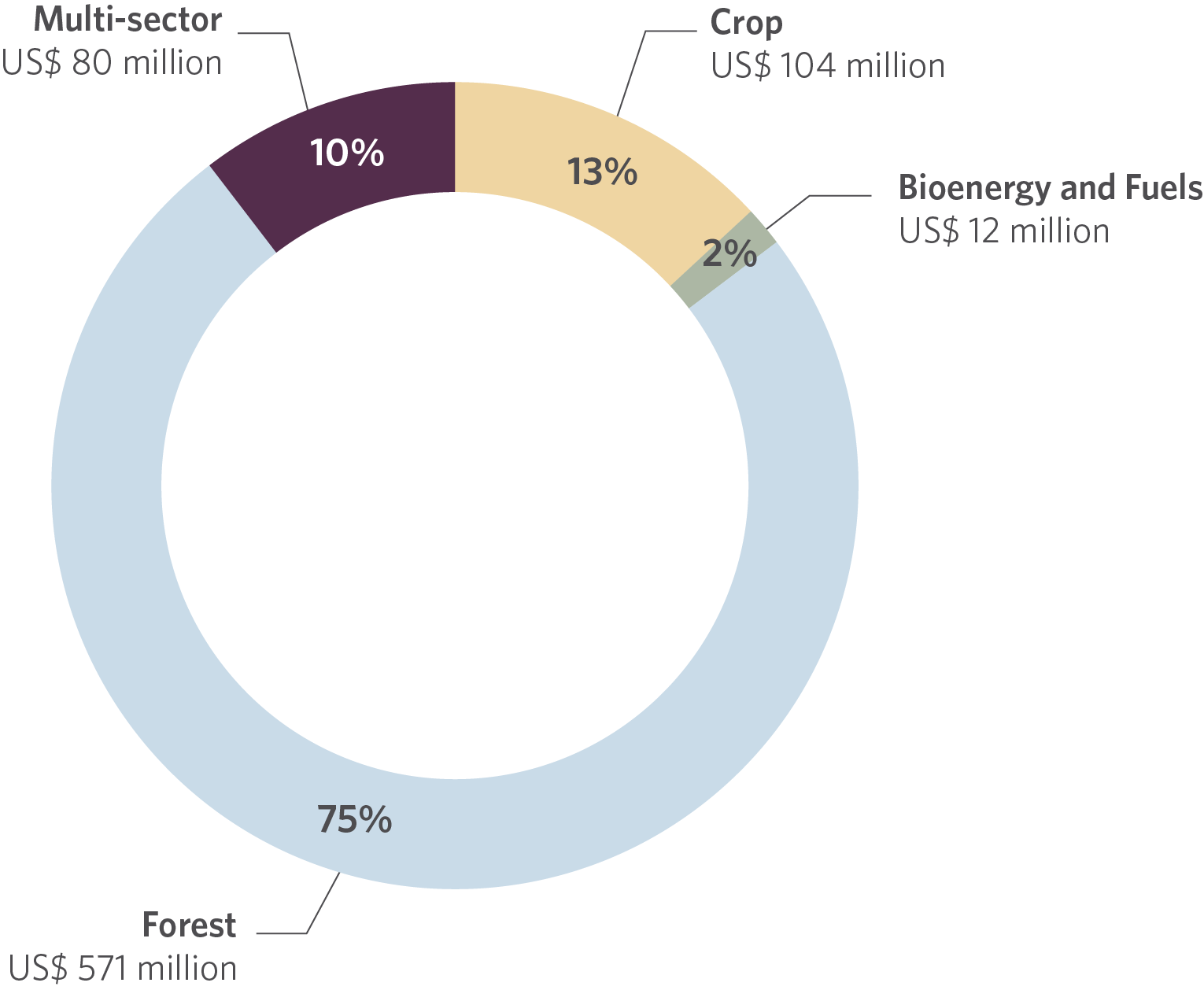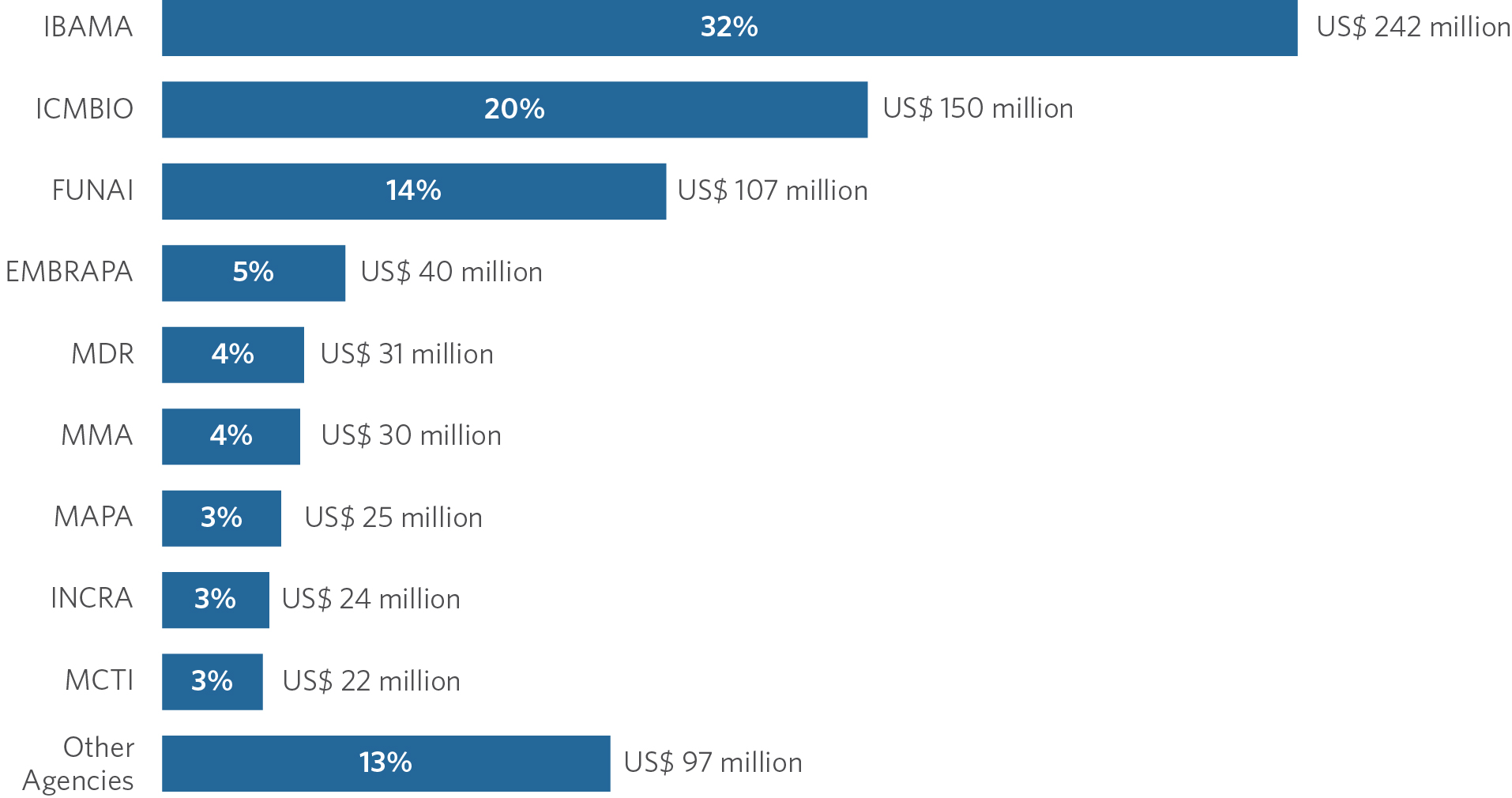Expenditures from the federal public budget geared towards climate finance for land use totaled, on average, US$ 767 million/year between 2015 and 2020, which accounts for 11% of the total amount tracked for that period. The public budget is the main instrument for channeling finance for policies in the forest sector. Approximately US$ 571 million/year in the forest sector were directed to activities (see Figure 7). The budget allocated to climate-aligned federal government actions for the crop sector totaled US$ 103 million/year, whereas the allocation for multi-sectoral activities totaled US$ 79 million/year).
Figure 7. Climate Finance via Public Budget by Sector, 2015-2020

Note: The values refer to the average amount in Brazilian Real (R$) during the analyzed period, deflated by the IPCA using December 2020 as reference. The values were converted into United States Dollar (US$), according to the average exchange rate for the corresponding year, as provided by the Central Bank of Brazil (Banco Central do Brasil – BCB).
Source: CPI/PUC-Rio with data from Siop/MPO, 2022
Public budget finance were mainly channeled via government agencies linked to the Ministry of the Environment and Climate Change (Ministério do Meio Ambiente e Mudança do Clima – MMA), particularly the Brazilian Institute of Environment and Renewable Natural Resources (Instituto Brasileiro do Meio Ambiente e dos Recursos Naturais Renováveis – IBAMA), at a rate of (US$ 241 million/year, and the Chico Mendes Institute for Biodiversity Conservation (Instituto Chico Mendes de Conservação da Biodiversidade – ICMBio) at(US$ 150 million/year (see Figure 8). The Brazilian Indigenous Peoples Foundation (Fundação Nacional dos Povos Indígenas – FUNAI), which was linked to the Ministry of Justice and Public Security (Ministério da Justiça e Segurança Pública – MJSP) between 2015 and 2020, also channeled US$ 107 million/year in climate finance.[1]
More than half of the climate finance channeled via the public budget was directed to IBAMA, ICMBIO, FUNAI and Brazilian Forest Service (Serviço Florestal Brasileiro – SFB), with the largest portion geared towards civil servants’ payroll expenses (US$ 345 million/year) and the management and maintenance of administrative structures (US$ 73 million/year). These expenses are key to the execution of actions related to land use and that contribute to climate mitigation and adaptation.[2] An additional US$ 163 million/year in climate finance were also allocated to strategies and policies related to forest sector activities.
Figure 8. Climate Finance via Public Budget by Government Agency, 2015-2020

Note: The values refer to the average amount in Brazilian Real (R$) during the analyzed period, deflated by the IPCA using December 2020 as reference. The values were converted into United States Dollar (US$), according to the average exchange rate for the corresponding year, as provided by the Central Bank of Brazil (Banco Central do Brasil – BCB).
Source: CPI/PUC-Rio with data from Siop/MPO, 2022
The mandates of these environmental agencies are tied directly to activities that help Brazil meet its climate commitments to reduce GHG emissions. IBAMA is a key player in combating deforestation across the country, as it is in charge of command and control activities to combat deforestation and protect native vegetation on federal lands. The agency also operates as a national environmental authority and has the mandate to inspect and issue administrative sanctions for environmental violations.
ICMBio is responsible for proposing, implementing, managing, protecting, inspecting, and monitoring federal protected areas (Unidades de Conservação – UCs). These activities in the protected areas channeled an average of US$ 34 million/year between 2015 and 2020.
During this period, the public budget also financed US$ 22 million/year in actions to prevent and control deforestation and wildfires; IBAMA (US$ 15 million/year) and ICMBio (US$ 6 million/year) were the main agencies to disburse finance for these purposes.
FUNAI, on the other hand, coordinates the demarcation process of lands traditionally occupied by indigenous peoples, in addition to monitoring and inspecting such lands.
Activities pertaining to environmental and land regularization and territorial planning – key factors to the success of policies against deforestation – received US$ 16 million/year in finance via the public budget, executed mostly by FUNAI (US$ 5 million/year) and National Institute for Colonization and Agrarian Reform (Instituto Nacional de Colonização e Reforma Agrária – INCRA) (US$ 6 million/year).[3] INCRA is the agency responsible for implementing agrarian reform policy, through the creation and management of rural settlements, and for carrying out national land planning. INCRA is responsible for the collection of vacant federal lands, the regularization of land ownership on public land, and the titling of land occupied by quilombola communities. Finally, INCRA manages two important databases, National Rural Credit System (Sistema Nacional de Crédito Rural – SNCR), used for agrarian reform, land and agricultural planning purposes, and the Land Management System (Sistema de Gestão Fundiária – SIGEF), which stores georeferenced information on properties and is spatial database used in property registration and land regularization.
The MMA is the central environmental authority, responsible for promoting strategies for the protection and recovery of the environment, the sustainable use of natural resources, and the inclusion of sustainable development in public policies (Antonaccio et al. 2018). This Ministry’s climate-aligned expenditures for land use totaled US$ 30 million/year, including only the direct expenditures of the MMA; the budgets of its related entities – IBAMA and ICMBIO – were analyzed separately. The MMA’s finance was disbursed for the management and maintenance of its administrative structure (US$ 14 million/year) and with the federal program Bolsa Verde, that ran from 2015 to 2017, channeled US$ 13 million/year, to the forest sector. Around US$ 13 million were spent via the public budget to pay the benefit to families, while US$ 1 million were invested in operating and monitoring the program.
In the crop sector, the public budget allocated US$ 39 million/year to R&D activities and knowledge management systems by means of the Brazilian Agricultural Research Corporation (Empresa Brasileira de Agropecuária – EMBRAPA). Rural extension received US$ 39 million/year, with disbursements by MAPA (US$ 22 million/year) and INCRA (US$ 16 million/year). Rural extension – a set of initiatives aimed at disseminating knowledge to rural producers – contributes to reducing environmental impacts by promoting the adoption of best practices in agricultural production, which are crucial to facing the challenges posed by climate change (Souza et al. 2022).
The volume of climate finance channeled via the public budget dropped from US$ 993 million in 2015 to US$ 394 million in 2020, a 39% reduction in real terms. This drop was mostly in expenses with the payroll of civil servants and with the management and maintenance of government agencies. A relevant portion of this drop in disbursements is tied to knowledge management systems and R&D activities, mainly by EMBRAPA and the Ministry of Defense.
CLIMATE FUND
The National Fund for Climate Change (Fundo Nacional sobre Mudança do Clima – FNMC), also called the Climate Fund, seeks to allocate resources to finance projects or studies related to climate change mitigation and adaptation. The fund was created in 2009. It is an instrument of the National Policy on Climate Change (Política Nacional de Mudança do Clima – PNMC) and is linked to the MMA.[4]
The Climate Fund is funded mainly by taxed revenues from national oil companies, but also receives funds from public and private institutions (CEPAL 2016).
The Climate Fund operates in two ways. Under the reimbursable modality, BNDES operates loans with finance from the fund by means of the Climate Fund Program. In the non-reimbursable modality, carried out by the MMA, finance is channeled via grants mainly to subnational government projects, which usually contribute with their own resources as a counterpart to the finance provided by the Fund.
Reimbursable funds from the Climate Fund were accounted for as low-cost credit operated by BNDES; they are analyzed in the Financial Market section of this report. Between 2015 and 2020, the BNDES Climate Fund Program approved US$ 15 million/year in climate finance for companies.
In the same period, the Fund’s non-reimbursable finance channeled by the MMA corresponded to US$ 1.5 million/year in climate finance. Municipal government projects (US$ 0.7 million/year) were the main beneficiaries.
[1] In 2023, FUNAI became linked to the Ministry of Indigenous Peoples (Ministério dos Povos Indígenas – MPI) instead, as mandated by Provisional Decree no. 1,154/2023.
[2] These expenditures were identified by the Federal Budget’s Nature of Expenditures Group (Grupo de Natureza de Despesa – GND) in (i) Personnel and Social Charges and (ii) Other Current Expenses.
[3] The US$ 16 million/year do not include public budget expenditures with protected areas – which, as mentioned above, were considered separately.
[4] The FNMC is an accounting fund created by Law no. 12,114/2009 and regulated by Decree no. 7,343/2010.

